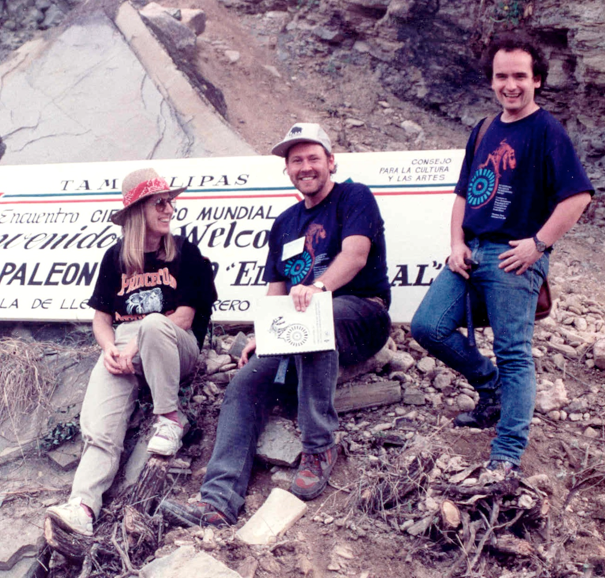
The Impact - Kill Hypothesis
The Cretaceous-Tertiary boundary (KTB) mass extinction is primarily known for the demise of the dinosaurs, the Chicxulub impact, and the frequently rancorous thirty years-old controversy over the cause of this mass extinction. Since 1980 the impact hypothesis has steadily gained support, which culminated in 1990 with the discovery of the Chicxulub crater on Yucatan as the KTB impact site and “smoking gun” that proved this hypothesis. In a perverse twist of fate, this discovery also began the decline of this hypothesis, because for the first time it could be tested directly based on the impact crater and impact ejecta in sediments throughout the Caribbean, Central America and North America.
Two decades of multidisciplinary studies amassed a database with a sum total that overwhelmingly reveals the Chicxulub impact predates the KTB mass extinction. It’s been a wild and frequently acrimonious ride through the landscape of science and personalities. The highlights of this controversy, the discovery of facts inconsistent with the impact hypothesis, the denial of evidence, misconceptions, and misinterpretations are recounted here. (Full paper in Keller, 2011, SEPM 100, 2011).
It all began with the discovery of a sharp peak of anomalous iridium concentrations in a thin clay layer (redox boundary) at the KT boundary near Gubbio, Italy, by Walter Alvarez, Luis Alvarez, his physicist father and Nobel Prize winner, and their collaborators Frank Asaro and Helen Michel in 1979. Iridium occurs in concentrations in some meteorites and deep within the Earth, where it is brought to the surface by volcanic eruptions. It was reasoned that a volcanic Ir source could not have resulted in a sharply peaked concentration because eruptions would occur over a long time, whereas a meteorite crashing into Earth could leave this telltale anomaly in a single instant and cause the mass extinction. Their hypothesis, published in 1980 (Alvarez et al., 1980), proposed that a large impact crashed into Earth 65 m.y. ago and caused the KTB mass extinction as a direct result of corollary effects including darkness from dust clouding the sun and causing a nuclear winter and global wildfires. Today, these corollary effects have been ruled out and the assumption that the KTB Ir anomaly must be extraterrestrial is increasingly questioned with new data from Deccan volcanism, the presence of multiple Ir anomalies as a result of remobilization and concentration at redox boundaries, and the absence of Ir anomalies associated with Chicxulub impact glass spherules, the only undisputed ejecta from this impact (Colodner et al., 1992; Sawlowicz, 1993; Miller et al., 2010; Martin-Peinado and Rodriguez-Tovar, 2010; Gertsch et al., 2011).
Although meteorites crashing into Earth is well documented through history and the idea that this could cause mass extinctions was proposed as early as 1700s, this was the first time that actual supporting evidence, an Ir anomaly, lent substance and credence. It was no longer a wild guess, but a testable hypothesis. Anyone could look for the impact signal and evaluate the tempo and severity of extinctions. This was an exciting and major breakthrough for science, and it began to attract scientists from diverse fields.

Figure 2. The meteorite of Ensisheim, Germany, crashed into a wheat field on Nov. 7, 1492.
Unfortunately, this wide interest rarely resulted in integrated interdisciplinary studies or joint discussions to search for common solutions to conflicting results. Increasingly, in a perverse twist of science new results became to be judged by how well they supported the impact hypothesis, rather than how well they tested it. An unhealthy US versus THEM culture developed where those who dared to question the impact hypothesis, regardless of the solidity of the empirical data, were derided, dismissed as poor scientists, blocked from publication and getting grant funding, or simply ignored. Under this assault, more and more scientists dropped out leaving a nearly unopposed ruling majority claiming victory for the impact hypothesis. In this adverse high-stress environment just a small group of scientists doggedly pursued evidence to test the impact hypothesis.

Figure 3. Gerta Keller, Wolfgang Stinnesbeck and Thierry Adatte leading NASA LPI (1994) sponsored field trip to NE Mexico to investigate evidence of the Chicxulub impact and its age.
No debate has been more contentious during the past thirty years, or has more captured the imagination of scientists and public alike, than the hypothesis that an extraterrestrial bolide impact was the sole cause for the KTB mass extinction (Alvarez et al., 1980). How did this hypothesis evolve so quickly into a virtually unassailable “truth” where questioning could be dismissed by phrases such as “everybody knows that an impact caused the mass extinction”, “only old fashioned Darwinian paleontologists can’t accept that the mass extinction was instantaneous”, “paleontologists are just bad scientists, more like stamp collectors”, and “it must be true because how could so many scientists be so wrong for so long.” Such phrases are reminiscent of the beliefs that the Earth is flat, that the world was created 6000 years ago, that Noah’s flood explains all geological features, and the vilification of Alfred Wegner for proposing that continents moved over time.
How did this happen? A closer look at the factual evidence, underlying reasoning, and development of the impact hypothesis into an almost unassailable bulwark reveals an interaction between scientific investigations, exuberant belief in the rightness of the impact hypothesis, and public media fascination.

